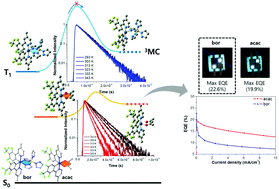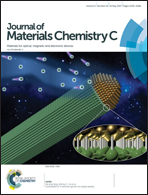Important role of ancillary ligand in the emission behaviours of blue-emitting heteroleptic Ir(iii) complexes†
Abstract
A series of heteroleptic Ir(III) complexes composed of 2-(2,4-difluoro-3-(trifluoromethyl)phenyl)-4-methylpyridine (dfCF3) as the main ligand and such ancillary ligands as acetylacetonate [Ir(dfCF3)2(acac)] (acac), picolinate [Ir(dfCF3)2(pic)] (pic), and tetrakis-pyrazolyl borate [Ir(dfCF3)2(bor)] (bor) were prepared, and their emission behaviors depending on the ancillary ligands were systematically investigated. It was found that the Huang–Rhys factors (SMs) of the emission decrease in the order bor (0.97) > acac (0.87) > pic (0.76), while the nonradiative rate constants (knr/105 s−1) calculated from the quantum yields and lifetimes of emission were in the order acac (4.89) > pic (1.17) > bor (0.28). It was assumed that the large difference of knr for the complexes arose from important contributions of the ancillary ligands to the crossing from an emissive state (3MLCT) to a nonemissive metal-centered state (3MC). The activation energies for the crossing from 3MLCT to 3MC were estimated from the temperature dependencies of the emission lifetime and were found to be 46 meV for acac, 61 meV for pic, and >100 meV for bor. The experimental results were in line with the theoretical calculations based on integrating quantum chemical modeling methods. By the excellent emission behavior, bor was applied as a dopant to prototype deep-blue phosphorescent organic light-emitting diode devices, which revealed high emission efficiency and colour purity.



 Please wait while we load your content...
Please wait while we load your content...